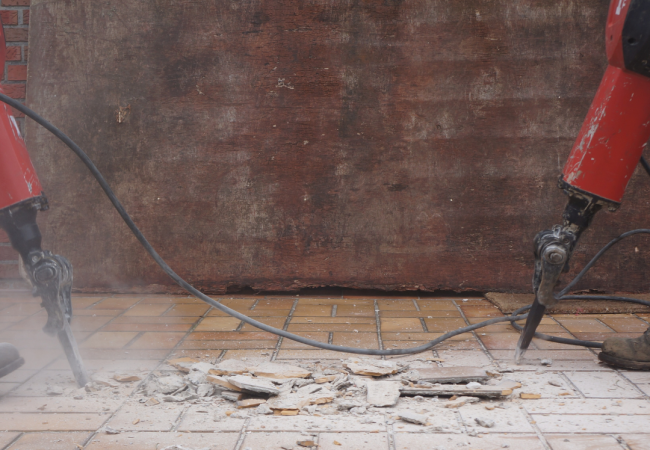Common Mistakes to Avoid during Concrete Removal
Concrete removal may seem like a straightforward task, but without proper planning and execution, it can quickly turn into a costly and time-consuming endeavor. Whether you’re renovating your home, upgrading your outdoor space, or undertaking a large-scale construction project, avoiding common mistakes during concrete removal is essential for success. In this blog post, we’ll explore some of the most prevalent pitfalls that individuals and contractors encounter when removing concrete and offer practical tips to help you steer clear of them. From inadequate preparation and improper equipment usage to overlooking safety protocols, each mistake can lead to setbacks and frustrations. By understanding these pitfalls and learning how to avoid them, you can streamline the concrete removal process, save time and money, and ensure your project progresses smoothly. Let’s dive into the key mistakes to steer clear of when tackling concrete removal.
Underestimating Safety Precautions: A Guide to Safe Concrete Removal
Concrete removal may seem like a straightforward task, but it can be hazardous if safety precautions are underestimated or ignored. Whether you’re tackling a small DIY project or overseeing a large-scale demolition, prioritizing safety is paramount to prevent accidents and injuries. In this guide, we’ll explore essential safety measures to ensure a smooth and secure concrete removal process.

Conduct a Site Assessment
Before starting any concrete removal project, conduct a thorough assessment of the site. Identify potential hazards such as overhead power lines, buried utilities, or unstable structures. Clear the area of debris and ensure there’s ample space for equipment and personnel to maneuver safely.
Wear Proper Personal Protective Equipment (PPE)
Personal protective equipment is your first line of defense against injuries during concrete removal. Wear a hard hat, safety glasses, hearing protection, and steel-toed boots to protect yourself from falling debris, dust, and noise. Additionally, consider wearing gloves and a respirator to safeguard against skin irritation and respiratory issues caused by concrete dust.
Use the Right Tools for the Job
Using the appropriate tools and equipment is crucial for safely removing concrete. Avoid makeshift or improper tools, as they can increase the risk of accidents. Depending on the scope of the project, you may need jackhammers, concrete saws, demolition hammers, or excavators. Familiarize yourself with each tool’s operation manual and follow manufacturer recommendations for safe usage.
Establish a Safety Zone
Create a designated safety zone around the work area to prevent unauthorized access and keep bystanders at a safe distance. Use barriers, signage, and caution tape to clearly mark the perimeter of the zone. Communicate safety protocols to all personnel involved in the project and enforce strict adherence to ensure everyone’s well-being.
Practice Safe Material Handling
Handling heavy concrete debris requires proper lifting techniques and equipment. Avoid lifting objects beyond your capacity and use mechanical aids such as wheelbarrows, dollies, or forklifts when necessary. Lift with your legs, not your back, and maintain a stable stance to prevent strains and injuries.
The Importance of Proper Tools and Equipment in Concrete Demolition
Effective concrete demolition requires more than just brute force—it demands the right tools and equipment for the job. From handheld tools like jackhammers to heavy machinery like excavators, each piece of equipment plays a crucial role in the demolition process. In this guide, we’ll delve into the significance of using proper tools and equipment for concrete demolition and how they contribute to efficiency, safety, and successful project outcomes.
Selecting the Right Tools for the Task
Choosing the appropriate tools is essential for tackling various aspects of concrete demolition efficiently. For smaller projects or precise work, handheld tools like jackhammers, demolition hammers, and concrete saws are ideal. These tools offer maneuverability and precision, allowing operators to target specific areas without causing unnecessary damage to surrounding structures.
Enhancing Efficiency and Productivity
Using specialized tools and equipment can significantly enhance the efficiency and productivity of concrete demolition projects. Heavy machinery such as excavators, bulldozers, and skid-steer loaders can quickly break apart large concrete structures and clear debris with minimal manual labor. This streamlines the demolition process, reduces labor costs, and accelerates project timelines, ultimately saving time and resources.
Minimizing Damage to Surrounding Structures
Proper tools and equipment enable controlled demolition, minimizing collateral damage to adjacent structures or property. Precision tools like concrete saws allow operators to make clean, straight cuts, reducing the risk of accidental damage to nearby walls, floors, or utilities. This precision is especially crucial in urban or densely populated areas where space is limited, and neighboring structures must be protected.
Ensuring Operator Safety
Safety is paramount in concrete demolition, and using the right tools and equipment is essential for protecting operators from harm. Handheld tools are equipped with safety features such as vibration dampening systems, ergonomic handles, and trigger locks to reduce operator fatigue and minimize the risk of musculoskeletal injuries. Heavy machinery is designed with reinforced cabs, rollover protection systems, and advanced controls to safeguard operators from accidents and hazards on the job site.
Adapting to Project Requirements
Every concrete demolition project is unique, with its own set of challenges and requirements. Having a diverse range of tools and equipment allows contractors to adapt to various project specifications and conditions effectively. Whether it’s breaking up reinforced concrete, removing thick slabs, or cutting through asphalt, having the right tools on hand ensures versatility and flexibility in tackling diverse demolition tasks.
Beyond the Surface: Common Mistakes When Removing Concrete Foundations
Removing a concrete foundation is a significant undertaking that demands careful attention to detail. From safety concerns to environmental considerations, avoiding common mistakes is essential for a successful demolition project.
- Underground Utilities: Failure to identify and properly handle underground utilities can lead to costly damages and safety hazards. Always conduct thorough utility checks before excavation.
- Structural Support: Neglecting to adequately support adjacent structures during foundation removal can result in unexpected collapses or damage. Ensure proper shoring and bracing to protect surrounding buildings.
- Environmental Impact: Improper disposal of concrete waste can have detrimental effects on the environment. Follow local regulations and explore recycling options to minimize your project’s ecological footprint.
- Equipment Selection: Using the wrong equipment or tools for foundation removal can prolong the process and increase the risk of accidents. Invest in quality machinery suited for the specific demands of the job.
Conclusion
Understanding and avoiding common mistakes during concrete removal is pivotal for ensuring a smooth and efficient process. As highlighted by JUNKAHAULICS – Raleigh, meticulous planning, proper equipment usage, and adherence to safety protocols are paramount. By sidestepping pitfalls like inadequate preparation, improper tool selection, or overlooking safety measures, individuals can mitigate risks, minimize disruptions, and achieve satisfactory results in concrete removal projects. Embracing these insights not only enhances project outcomes but also safeguards against costly errors, positioning stakeholders for success and long-term satisfaction.




